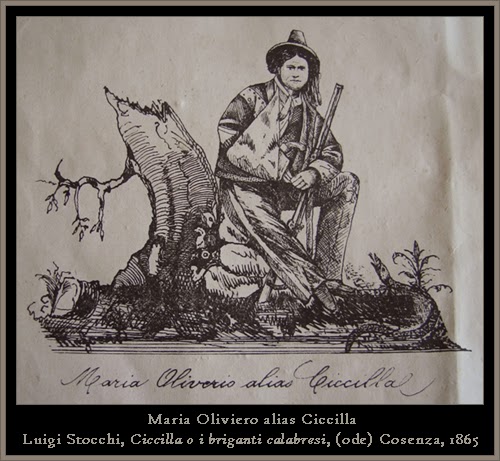EXCERPT from Italian Wikipedia:
At the age of twenty, Maria Oliviero murdered her sister, hacking her 48 times with an axe for slander and joined the gang of her husband, Pietro Monaco. She was arrested in 1864 and went on trial in February, was charged with 32 crimes: kidnapping, violent robberies and thefts, fires, and murders. She confessed to the murder of his sister, but for the rest she claimed she was coerced into participating.
***
FULL
TEXT (Article 1 of 2): A Turin letter states that among the Neapolitan provinces which
have to contend with the dreadful scourge of brigandage there is that of
Cattanzaro, which possesses the advantage of having a band which is led
by Maria Oliviero, an exceedingly handsome woman, not yet thirty years
of age. Barbarity is her chief characteristic, and the sight of blood
renders her as excited as a wild beast. She was the wife of a famous
brigand, Moneco, of the Albanian village of Spezzano, who was killed in
an encounter with the Italian troops near Rossano. In this very
encounter Maria was also wounded, but she continued to discharge her
musket, kneeling on the dead body of her husband, with a firmness and a
courage which even commanded the admiration of her opponents. Having at
last been struck in the right leg, she fell into the hands of the
troops, was brought before a court-martial at Cattanzaro, and condemned
to be shot.
The
sentence was, however, commuted to thirty years penal servitude. While
she was expiating her crimes in the prison at Cattanzaro the gaoler fell
desperately in love with her. The cunning woman pretended to feel an
equal affection for him, and one day she told him that while she was
with her husband she had concealed in at place near Rossano a large sum
of money, which had been paid for the ransom of a rich farmer. The
gaoler went quickly to the spot and found the money.
This
fact had naturally the effect of making his love for Maria still more
ardent, so that she had no difficulty in convincing him that tender
affections are better manifested in freedom than within the four walls
of a dungeon. Before, however, making their escape Maria succeeded in
sending word to her brothers, who are brigands, that on a certain
evening she would be at an appointed spot, not far from Cattanzaro,
attired in man’s clothes, together with her deliverer. Maria was
punctual at the rendezvous, and her brothers also. The unfaithful
turnkey was killed out of hand, and the money he had found replaced in
Maria’s pocket. Once free, this woman organised a band of brigands, and
began her operations in that tract of mountains which lie between the
river Crati and Cattanzaro.
The
barbarities since perpetrated by Maria are almost incredible. The
villages of Spinelli, Cotzenei, and Belvedere have been literally sacked
by the band she commands. The dread which the name of Maria Oliviero
inspires among the rural population of Cattanzaro is so great that the
Italian government have been obliged to send two battalions of the line
to pursue the cruel fury.
While
the band led by this woman is desolating the country of Cattanzaro, we
hear from Rionre that Bersaglieri have succeeded at last in capturing
the famous brigand, Sacchitiello, together with the two still more
famous mistresses of the brigands Crocco and Schiavone.
The strangest thing about the capture of Sacchitiello, and the two women, is that they were taken in the house of the captain of the National Guard of the village, where they had been concealed since the month of July. This fact shows how difficult it is to get rid of the Neapolitan brigands, since, in certain cases, the commanders of the National Guard give them safe shelter in their very houses.
The strangest thing about the capture of Sacchitiello, and the two women, is that they were taken in the house of the captain of the National Guard of the village, where they had been concealed since the month of July. This fact shows how difficult it is to get rid of the Neapolitan brigands, since, in certain cases, the commanders of the National Guard give them safe shelter in their very houses.
[“A Female Brigand – Her Atrocities,” Camden Democrat (N.J.), Mar. 4, 1865, p. 1]
***
For similar cases, see: Female Serial Killer Bandits
FULL TEXT (Article 2 of 2): From the Liverpool Post. – We recently published
some intelligence respecting brigandage in Italy which discloses one of the
most abnormal of the phenomena connected with that barbarous anachronism. The
system which is now going on in the name of religion and Divine right is not
like ordinary brigandage. It seems a relic of some ancient state of society
which has long since passed away. If those monstrous and carnivorous animal
forms which we have seen in stucco at Sydenham were to reappear, again in the
flesh, they could hardly be more out of date. It is not merely that the loyal
and devout brigands, in their zeal for the service of the Church and the
Ex-King of Naples, do not content themselves with vulgar robbery and murder,
and delight in mutilation and burning alive, but that women are actually found
to join in these things, and to emulate the men in cruelty and ferocity. This
extraordinary combination of devotion and loyalty with brigandage and
cannibalism, is a marvellous phenomena, and warns us what fanaticism may become
when divorced from morality. No doubt the appetite for plunder may be at the
bottom, but there is also very sincere faith that at least one of the ends
sought to be attained sanctions the nefarious means employed to promote it.
The band of NICOLI MASINI has for four years been the terror
of the Basilicata. During all this time it has been incessantly engaged in
robbing and murdering, mutilating and burning alive the unfortunate wretches
who happened to fall into its hands. It consists of about seventeen persons,
but three of them are women, who are described as being more blood-thirty and
pitiless than the men. Whatever the inferiority of woman may be to man in
physical strength and power of mind generally, in this case it would appear
that the brigandesses have vindicated for themselves not merely a bad equality,
but a bad preeminence. One of the most curious circumstances of the case, too,
is that these ladies appear to have been originally carried off by force. Their
connection with the brigands appears in its origin to have been a kind of
Sabine rape, only upon a very reduced scale.
Another difference seems to consist in this band of brigands
not having been able to procure or to maintain a wife apiece for each man, as
the Romans are said to have done. It had to be content with three wives, the
rest of the gang, of course, remaining bachelors. Whether it is one of the
exaggerations of romance with which each incidents are pretty pure to be
decorated, or whether it is simple matter of fact, we do not know; but,
according to the statement before us, these three brigandesses are young and
beautiful. What, however, lends a color of probability to this is, that it is
not likely the bandits would have been at the trouble of carrying off brides
who were elderly and plain. The whole gang is now, luckily, in custody, and
will soon be brought to trial. As the counsel for the ladies are not, we
suppose, in a position to produce the marriage certificates of their fair
clients, and as the Italian law might not hold those scraps of paper to be a
sufficient justification for any crime which a wife might commit, it only she
did it in company with her husband, it is presumed that these cannibalesses
will not be allowed to escape with impunity. There are said to be no less than
314 distinct charges against them for crimes the they are known to have
committed. What proportion the number of crimes that may not have been brought
home to the band bears to this, is of course impossible to say. The known
number gives an average of rather more than eighteen crimes a head for the
brigands and brigandesses uniformly. Among these charges, besides more robbery,
the crimes of mutilation, murder and burning alive are said to figure
conspicuously. To extend an ill-judged lenity [sic] to such persons, is practically
to offer a direct premium for the perpetration of the crimes to which they have
devoted their lives.
This phenomenon of female brigandage is not, however, by
any means peculiar to the band of NICOLA [Nicoli?] MASINI. We have seen that
these brigandesses have an average of eighteen crimes against them in common
with the men. But they have not yet risen to a level with one of their fair
predecessors, a certain MARIA OLIVIERI, of Calabria. This incomparable heroine,
when she was arrested about a year ago, had no less than forty distinct capital
charges against her. Forty murders she was known to have committed, and one of
her victims was her own sister. She also was described as young and beautiful;
and if in these qualities she did not surpass the three amazons of MASINI's
band, she must be at least allowed to hold a far higher rank as a homicide. The
most authentic account given of her states that she was a very fine-looking
young woman indeed, and was certainly not more than twenty-three years of age.
Forty murders would, therefore, be at the average rate of almost a couple for
every year of her short life. Whether the brigandesses as well as the brigands
are primarily actuated by the desire of plunder, but seek to turn their
favorite avocation to account in the service of their church and their king,
must furnish the element of an interesting problem. Those who patronise and
encourage such worthies, of course take care to impress upon their credulous,
superstitious minds that by serving the cause of Divine right, and fighting the
good fight of the soldiers of the faith, at the same time that they are filling
their pockets with the money found in farm-houses and upon travelers on the
highway, they will be laying up for themselves treasures in heaven. And of
course the ignorant brigands firmly believe what their priests tell them. In
the eyes of fanatics of this sort morality, and religion have nothing whatever
to do with each other. So long as they do the bidding of their spiritual
guides, repeat by rote the set number of prayers, abstain from eating meat on
fast-days, and go through the other prescribed formalities, they are in no fear
about their soul's health. The Italian brigand, and therefore, we suppose, this
new development, the Italian brigandess also, is traditionally a very pious
animal, as he understands the meaning of piety. Having fulfilled the higher
obligations of his law, he feels he may safely dispense with such insignificant
duties as honesty and morality. What, indeed, would be the use, he seems to
argue with himself, though perhaps half unconsciously, of so strict an
adherence to his religious rites if it did not purchase a corresponding
immunity from the inconvenient restraints of more secular virtue? This would
apply in the case of mere vulgar brigandage in ordinary times, when there was
no forlorn and fugitive King, no persecuted faith to champion. But now the
brigand not merely enjoys the privilege of a moral carte blanche, in
consideration of a strict observance of pious forms, but he is enjoined to use
his carbine and his dagger in the service of his church and his king; and, what
is more, he serves himself profitably in serving them. Of old time, the
traditional brigand was generally depicted with his wife to cheer the solitude
of his retreat. But she was a domestic household personage of the ordinary
type. She might, indeed – if his cave in the rocks, or his hole burrowed in
the side of a hill, were scented out by the minions of justice – seize a
carbine or a dagger and fight for her life; but murder and robbery were no part
of her ordinary duty. That department was left to the brigand. The sphere of activity
in which the brigandess occupied herself was the preparation of the meals, the
sorting and storing away of the booty, and the like. But this is an age of
progress with development in all things, and the brigandess is asserting her
equality with her lord and master the brigand. Still, there must be some new
principle at work to account for this singular phenomenon. That women might
like to vote at elections, and even to represent their fellow-citizenesses in
Parliament, or to dress like bloomers, one can understand. But why should
woman, naturally more timid than man, brave all the perils of brigandage when
she might stay quietly at home and leave such dangerous work to her husband? It
is because women, being more susceptible to superstitious influences than men,
have, for obvious reasons, been worked upon for sinister and evil purpose by
those who are interested in promoting brigandage in Italy.
[“Brigandage In Italy.; Beautiful But Cruel Female Robbers.”
(From the Liverpool Post) New York Times (N.Y.), May 28, 1865, p. 2]
***
***
Aug. 30, 1841 – born, Maria
Oliverio, known as Ciccilla,
Casole Bruzio.
Oct. 3, 1858 – age of 17, married Pietro Monaco,,
moves to hamlet of Macchia in the municipality of Spezzano Piccolo.
Mar.17, 1861 – King Victor Emmanuel II of Sardinia is proclaimed King of
Italy.
Mar. 1862 – arrested, along with her sister Teresa by
Major Pietro Fumel.
1862 – murders sister Teresa for slander, with 48
strokes of an ax and in the presence of Theresa’s three children.
May 1862 – joins Pietro Monaco’s band of brigands. Calabria; loyal
to king of Naples.
June 18, 1863 – Band seizes cousins Achille
Mazzei and Antonio Parisio in Santo Stefano (current Santo Stefano di
Rogliano); ransomed of 20 000 ducats.
Aug. 31, 1863 – Band seizes of 9 people, including nobles, religious
and owners of Acri.
Sep. 1, 1863 – General Giuseppe Sirtori assumes
command of operations against brigandage in Calabria Citra and Ultra.
Dec. 23, 1863 – monk killed by members of Monaco’s
Band.
Feb.15(?) 1864 – capture of Maria and Monaco’s Band.
Feb. 1864 – Charged in Catanzaro by the Calabria War
Tribunal, Ultra,Maria was sentenced to death.
Feb. 1864 – sentence commuted to life of hard labor.
1879
(circa) – Maria dies, presumably (but not certainly) at Fenestrelle
Fort, Turin.
[Source, Italian Wikipedia]
***
Beheading of Pietro Monaco – In an effort to repress
banditry, government agents would cut off the heads the brigands they killed
and put them on display, as a warning to the population. According to a poet
and journalist of the time, Luigi Stocchi, Maria tried to pursue the
killers, then returned from the corpse of her husband and beheaded him to
prevent the Piedmontese soldiers were doing it. She burned his head in a big
chestnut tree (still extant), near the place of the ambush and fled to Sila with her brother Raffaele, to her husband’s cousin
Antonio and to the rest of the gang who took refuge in the nearby caves.
Alexandre Dumas, offers a different version of events "One of the owners of
Cosenza who had been right to cruelly hurt his head ... he cut off the head of
Monaco, dried it in an oven and kept it indoors to adorn his desk"
[Italian Wikipedia]
***
For similar cases, see: Female Serial Killer Bandits
[3076-1/10/21]
***
















https://www.ibs.it/ciccilla-storia-della-brigantessa-maria-libro-peppino-curcio-alexandre-dumas/e/9788881016938
ReplyDelete